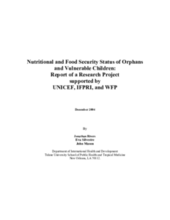One of the major challenges facing governments, international organizations and NGOs in their response to the rapidly rising number of orphans and vulnerable children is the lack of data on the situation of orphans, and on the quality and effectiveness of interventions. Continuous assessments of national strategies aimed at improving the welfare of orphans are needed in order to assess the effectiveness of these interventions. A key area is the food and nutrition situation of orphans and other children made vulnerable by HIV/AIDS. Inconsistent findings make it difficult to assess if orphans and other vulnerable children have specific nutritional needs separate from other children.
This report looks to address this issue by establishing the present nutritional status of orphans in sub-Saharan Africa by examining a large number of countries in the region. Specifically, the report answers: a) To what degree is child anthropometry and household food security affected by orphanhood and chronic sickness?, b) Is underweight the most appropriate indicator to measure the nutritional status of orphans?, c) Which types of households are most affected by food insecurity and which indicators show promise for future monitoring?, and d) How does the concept of vulnerability relate to food security?
In order to answer these questions, 30 DHS and MICS II surveys, 2 Sub-national UNICEF surveys from Blantyre, Malawi and Kingston, Jamaica, and 6 C-SAFE/WFP surveys were utilized. Since the core nutrition indicator (underweight) is limited to measuring the nutritional status of younger children, and the majority of orphans are adolescents, an additional food security indicator was developed. Part of the analysis of the food security status of orphans involved first validating this food security instrument that was field-tested in Blantyre and Kingston.
The main findings of this report include:
-
The proportion of projected orphans is similar to the proportion surveyed in the DHS and MICS surveys.
-
Expected age distribution of orphans is similar to the age distribution observed from the surveys.
-
Orphan children were not worse off in terms of anthropometry than other children, after adjusting for age differences, and taking into account the presence of surviving parents in the household. This relationship held after stratifying for place of residence and sex of the head of household.
-
Children whose parents were alive, but not living in the household (children being fostered) were consistently better-off in terms of anthropometry than other children.
-
Children in institutions in Blantyre and Kingston were worse-off nutritionally than children residing in households. This difference is most convincing in Kingston.
-
Anthropometric indicators for children 6-8 years of age did not associate with SES and sanitation variables as they do for children under the age of 5.
-
The food security instrument was found to be internally valid, using Cronbach alpha reliability testing, and responses from the questionnaire also appeared to correlate well (i.e. be sensitive to) poverty indicators.
-
There were clear associations between underweight and stunting in children and food security status of households in Blantyre. A much larger percentage of orphans live in households that are classified as food insecure with child hunger.
-
40% of households with more than one orphan were classified as food insecure with child hunger.
-
Households with chronically sick members were also found to be more food insecure.
©Tulane University School of Public Health and Tropical Medicine

